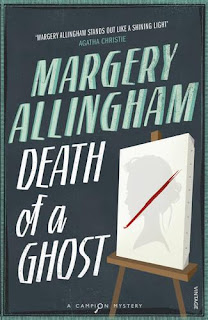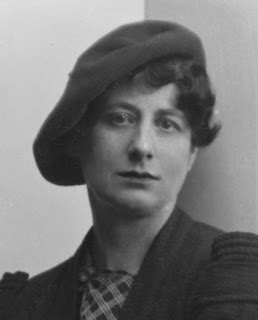Campion
risks his life to try to bring an audacious killer to justice

The Vintage edition of
Death of a Ghost
Death
of a Ghost, Margery Allingham’s sixth novel to feature the gentleman adventurer Albert
Campion, was first published in the UK in 1934.

Death of a Ghost
In
a note about Campion at the beginning of the book, the author observes that her
hero is an adventurer, whose exploits are sometimes picaresque, as in Mystery
Mile and Sweet Danger, but he sometimes faces grave difficulties, as in Police
at the Funeral. She warns that Death of a Ghost falls into the second category.
When
the story starts, preparations are being made for a party at the London home of
John Lafcadio, an artist who has been dead for 18 years. It is the eve of the
annual ceremony for the unveiling of one of the series of 12 paintings he has left
behind in a bid to keep his memory alive.
Campion,
who is a friend of the painter’s widow, Belle, visits her the day before the
ceremony and attends the unveiling occasion the following evening. When the
ceremony is interrupted by a daring and particularly brutal murder, Campion
calls in his good friend, Inspector Stanislaus Oates to investigate.
Suspicion
falls on a member of the family, but the police can’t find enough proof to make
an arrest. But when another murder is committed at the property, Campion decides
to investigate for himself to help his old friend, Belle.
I
found the novel slow at first, while lots of characters were being introduced
and described. The action didn’t really get under way until page 50.
Throughout
the novel, Campion seems passive, not behaving at all like the action man that
he was in Sweet Danger.
In
another departure from her previous stories, Margery reveals that Campion has
guessed the identity of the killer and names the person about 100 pages from the end of the book. He
says he has no means of proving it and fears for Belle’s safety, lamenting to
Inspector Oates that he is being outwitted by the killer.
Campion
seems strangely trusting to accept an invitation for a drink at the suspect’s
apartment and then to go out to dinner with a person he feels sure has committed
two murders.
He
allows himself to fall into a trap set for him by the suspect and then the
action heats up with Campion’s life in danger.
Peter Davison played Albert Campion in a
BBC TV adaptation of Death of a Ghost
The
writer Margery Allingham was born in 1904 in London and began writing at the
age of eight when she had a story published in a magazine.
Her
first novel was published when she was 19, but she did not make her
breakthrough as a crime writer until her novel, The Crime at Black Dudley, was
published in 1929. This introduced her series detective, Albert Campion, even
though he appeared only as a minor character in her first book.
He
was at first thought to be a parody of Dorothy L Sayers’s hero, Lord Peter
Wimsey, but Campion matured as the series of books progressed and proved there
was a lot more to him, becoming increasingly popular with readers.
Margery
Allingham is regarded as one of the four great Queens of Crime from the Golden
Age of detective fiction. One of her fellow Queens of Crime, Agatha Christie, once
said of the author: “Margery Allingham stands out like a shining light.”
Reviewers
have identified Death of A Ghost as a proper detective story rather than a high-spirited
thriller, but it differs from other detective stories of the time by having the
sleuth identify the killer and share his knowledge with the reader considerably
before the end of the book. The reader must wait for proof that Campion is right
and to find out whether the police will have enough evidence to arrest the suspect
and bring him to justice. But like all good mystery writers, Margery keeps a
few surprises up her sleeve until the end of the story.
Death
of a Ghost was filmed for the BBC in 1960, when Campion was played by Bernard
Horstall, and then again in 1989, when the role was played by Peter Davison.
Vintage
Books, part of the Penguin Random House Group, have now republished all
Margery’s novels featuring her series detective Albert Campion.





